Centre plans for ATM penetration across India: What are White Label ATMs and Brown Label ATMs?
Apart from dispensing cash, the White Label ATMs (WLAs) offer services including regular bill payment, cash deposit, account information, PIN Change and cheque book requests.

In a major initaitive to boost Automated Teller Machine (ATM) penetration in tier III to VI centres in India, the Reserve Bank of India (RBI) has permitted non-bank companies to set up, own and operate White Label ATMs (WLAs) in the country.
In a written reply to the Rajya Sabha last month, Minister of State for Finance Dr Bhagwat Kisanrao Karad said that in addition to dispensing cash for the customers of banks, the WLAs may offer other services including regular bill payment, cash deposit, account information, PIN Change and requests for cheque book.
For authorised non-bank entities are operating WLAs in India, said Karad. The RBI has allowed WLA Operators to source cash from retail outlets to address sourcing constraints in 2016.
The RBI has also encouraged more non-bank players to enter the ATMs industry by permitting WLA Operators to buy wholesome cash, offer bill payment and Interoperable Cash Deposit services and permitting banks to issue co-branded ATM cards.
What are White Label ATMs?
The ATMs that are set up, owned and operated by non-bank entities are referred to as White Label ATMs. Non-bank entities are allowed to operate ATMs under the Payment and Settlement Systems Act, 2007 by the RBI.
There are four White Label ATM operators in India. These companies are India1 Payments Limited, Hitachi Payment Services Pvt Ltd, Tata Communications Payment Solutions Ltd and Vakrangee Limited. The usage of these ATMs is no different from using the ATM of any bank, requiring a valid card and a personal identification number (PIN).
The WLAs also offer a range of services such as regular bill payment, cash deposit, account information, PIN Change and check book requests.
How are they different from Brown Label ATMs?
Unlike WLAs, Brown Label ATMs are those where the hardware and the lease of the machine is owned by a service provider, but the services of cash management and connectivity is operated by a bank whose brand is used on the ATM.
The service provider who owns the hardware of the ATM, is tasked with the responsibility of finding an ATM site, negotiating a lease agreement with the landlord and providing power supply to the machine kiosk. However, since the bank displays the brand of the bank, services are operated by the sponsor bank itself.
There are thousands of Brown Label ATMs across the country, as they have proved to be a cost effective initiative for the banks. While WLAs require a license from the RBI to operate, Brown Label ATMs don't have to interact directly with the central bank as the company has a contractual agreement with the sponsor bank.
As WLAs are increasing in numbers with assistance from the Central government, many experts say that the usage of BLAs is likely to dwindle.
Are there different labels for ATMs?
Yes, there are other ATM labels, apart from WLAs and BLAs. They can be distinguished into four different colours - Green, Pink, Yellow and Orange.
A Green Label ATM is used primarily for agricultural transactions and are used by farmers and rural customers. A Pink Label ATM is only accessed by women on the grounds of safety and convenience. A Yellow Label ATM is set up for the purpose of e-commerce and are used for online shopping and by merchants. An Orange Label ATM is used for share transactions.
ALSO READ | Provide option of cardless cash withdrawal at ATMs: RBI to banks